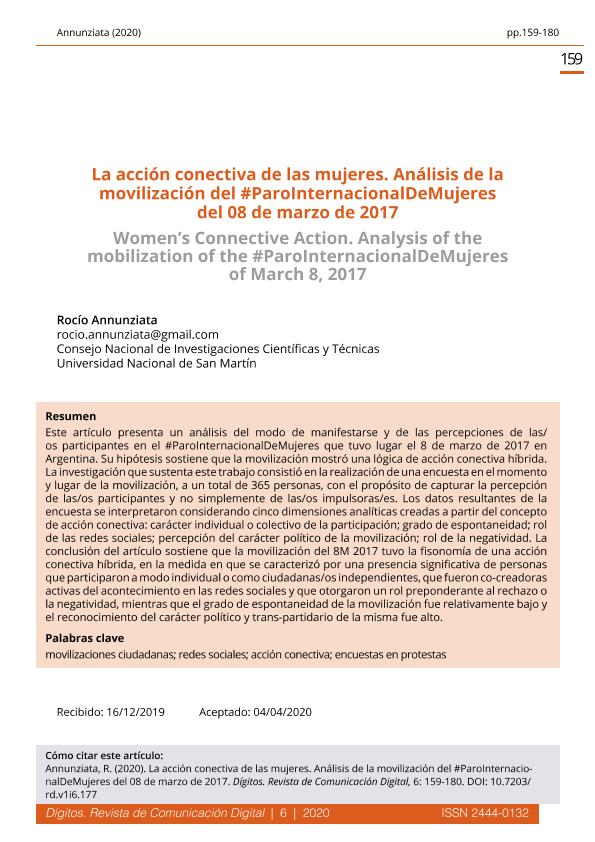Mostrar el registro sencillo del ítem
dc.contributor.author
Annunziata, Rocío

dc.date.available
2021-07-29T19:08:00Z
dc.date.issued
2020
dc.identifier.citation
Annunziata, Rocío; La acción conectiva de las mujeres: Análisis de la movilización del #ParoInternacionalDeMujeres del 08 de marzo de 2017; Universidad de Valencia; Dígitos; 6; 2020; 159-180
dc.identifier.issn
2444-0132
dc.identifier.uri
http://hdl.handle.net/11336/137373
dc.description.abstract
Este artículo presenta un análisis del modo de manifestarse y de las percepciones de las/ os participantes en el #ParoInternacionalDeMujeres que tuvo lugar el 8 de marzo de 2017 en Argentina. Su hipótesis sostiene que la movilización mostró una lógica de acción conectiva híbrida. La investigación que sustenta este trabajo consistió en la realización de una encuesta en el momento y lugar de la movilización, a un total de 365 personas, con el propósito de capturar la percepción de las/os participantes y no simplemente de las/os impulsoras/es. Los datos resultantes de la encuesta se interpretaron considerando cinco dimensiones analíticas creadas a partir del concepto de acción conectiva: carácter individual o colectivo de la participación; grado de espontaneidad; rol de las redes sociales; percepción del carácter político de la movilización; rol de la negatividad. La FRQFOXVLµQGHODUW¯FXORVRVWLHQHTXHODPRYLOL]DFLµQGHO 0 WXYRODȴVRQRP¯DGHXQDDFFLµQ FRQHFWLYDK¯EULGD HQODPHGLGDHQTXHVHFDUDFWHUL]µSRUXQDSUHVHQFLDVLJQLȴFDWLYDGHSHUVRQDV que participaron a modo individual o como ciudadanas/os independientes, que fueron co-creadoras activas del acontecimiento en las redes sociales y que otorgaron un rol preponderante al rechazo o la negatividad, mientras que el grado de espontaneidad de la movilización fue relativamente bajo y el reconocimiento del carácter político y trans-partidario de la misma fue alto.
dc.description.abstract
This article presents an analysis of the way of manifesting and the perceptions of the participants in the #ParoInternacionalDeMujeres that took place on March 8, 2017 in Argentina. Its hypothesis argues that the mobilization showed a logic of hybrid connective action. The research that supports this work consisted of conducting a survey at the time and place of the mobilization, to a total of 365 people, with the purpose of capturing the perception of the participants and not simply dimensions created from the concept of connective action: individual or collective nature of participation; degree of spontaneity; role of social networks; perception of the political nature of the mobilization; role of negativity. The conclusion of the article maintains that the mobilization of 8M 2017 had the appearance of a hybrid connective action, insofar as it was characterized by a active co-creators in the event on social networks and that gave a predominant role to rejection or negativity, while the degree of spontaneity of the mobilization was relatively low and the recognition of its political and trans-partisan character was high.
dc.format
application/pdf
dc.language.iso
spa
dc.publisher
Universidad de Valencia
dc.rights
info:eu-repo/semantics/openAccess
dc.rights.uri
https://creativecommons.org/licenses/by-nc-sa/2.5/ar/
dc.subject
MOVILIZACIONES CIUDADANAS
dc.subject
REDES SOCIALES
dc.subject
ACCIÓN CONECTIVA
dc.subject
ENCUESTAS EN PROTESTAS
dc.subject.classification
Otras Ciencia Política

dc.subject.classification
Ciencia Política

dc.subject.classification
CIENCIAS SOCIALES

dc.title
La acción conectiva de las mujeres: Análisis de la movilización del #ParoInternacionalDeMujeres del 08 de marzo de 2017
dc.title
Women's connective action: Analysis of the mobilization of the #ParoInternacionalDeMujeres of March 8, 2017
dc.type
info:eu-repo/semantics/article
dc.type
info:ar-repo/semantics/artículo
dc.type
info:eu-repo/semantics/publishedVersion
dc.date.updated
2021-07-19T18:49:39Z
dc.journal.number
6
dc.journal.pagination
159-180
dc.journal.pais
España

dc.journal.ciudad
Valencia
dc.description.fil
Fil: Annunziata, Rocío. Universidad Nacional de San Martín. Escuela de Política y Gobierno; Argentina. Consejo Nacional de Investigaciones Científicas y Técnicas; Argentina
dc.journal.title
Dígitos
dc.relation.alternativeid
info:eu-repo/semantics/altIdentifier/doi/http://dx.doi.org/10.7203/rd.v1i6.177
dc.relation.alternativeid
info:eu-repo/semantics/altIdentifier/url/https://revistadigitos.com/index.php/digitos/article/view/177
Archivos asociados
